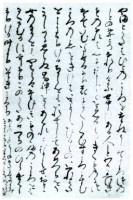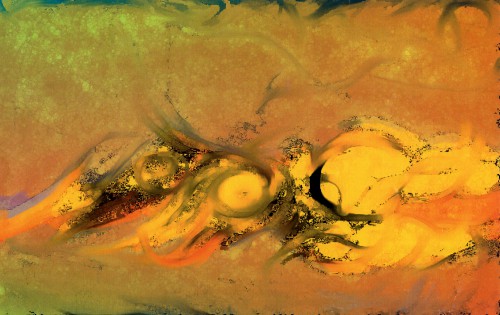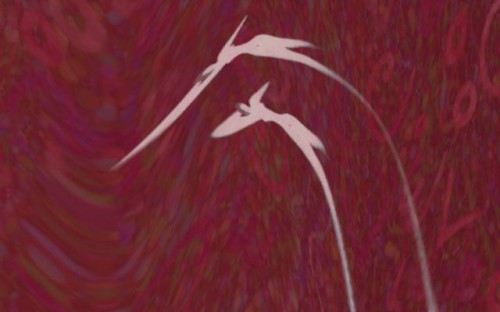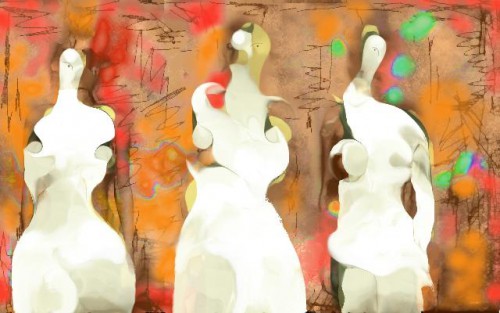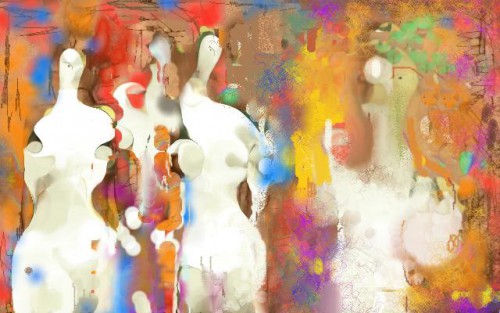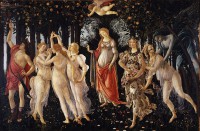連画ノート
Renga Note
安斎利洋 / Toshihiro ANZAI
十世紀のはじめに編集された古今集の仮名序に、次のような記述がある。
「(和歌は)力をも入れずして天地(あめつち)を動かし」
現代において、文学はわれわれがふだん生活をしている物理的空間の外にある隠喩的空間に発生すると考えられている。だれもがテレビドラマは虚構であることを理解し、虚構が現実を侵犯する危険はないと信じている。しかし近代以前において、隠喩的空間と物理的空間は地続きだった。詩は、ときには疫病の猛威を鎮め、ときには国家事業を成功に導くテクノロジーでもあった。古人は、力を入れずに対象に作用を及ぼす言葉の不思議な力に、驚きと感動をもっていた。今日、言葉のそのような豊かさは、すっかりやせ細ってしまったように思われる。
しかしいま、「力を入れないのに対象を動かすことができる」という表現は、われわれをとりまきつつある電子的なメディアにそのままあてはめることができる。現在、物理的空間と隠喩的空間を融合させているのは、ディジタルテクノロジーである。情報ネットワークは、長い間凍りついていた隠喩的空間を再び解凍し、われわれにその豊かさをもたらしてくれようとしている。同時にわれわれは電子的メディアの中での新しい体験の原型を、古人の表現活動のなかに発見することができる。
われわれのプロジェクト「連画」は、そのような古典と現代の接合する地点で発想された。
連画を思いつくきっかけとなったのは、1991年の冬に開かれたコンピュータペインティングに関するワークショップだった。なにかの拍子で、私の目の前のペイントシステムには中村理恵子の作品がロードされていた。完成された他人の作品に手を加えるのは、それがいかに無限に複製可能なディジタルデータであっても、心理的に抵抗があるものだ。 しかし私はそれに筆を入れ、アンドゥアイコンをクリックしてはそれをはじめの画像に戻すということを繰り返しはじめていた。その何気ない作業は、新鮮な驚きをもたらした。私はいつのまにかアンドゥすることも忘れてしまい、その作品をどんどん私流にアレンジしていき、ついには中村の作品の形跡をもった安斎の作品というハイブリッドを仕上げていた。
- Rieko NAKAMURA
- Toshihiro ANZAI
この刺激的な遊びを組織的な活動とするために、1992年の4月、私は中村にある創作の方法を提案をした。まずAがきっかけになるCG作品を完成させ、それをBに電子メールで送る。Bは、Aの手元の作品と完全に同じディジタル画像のコピーを受け取る。Bはそのデータをベースに、一部を加工したり、引用したりして、B自身の作品を完成させ、再びAに送り返す。このやりとりを繰り返すことによって、絵巻物のような作品の鎖を作れるはずだ。私はこの方法を、中世に流行した和歌の集団創作ゲームである連歌の発音に倣って、連画と名付けた。RENと発音する漢字「連」はlinkを意味する。「歌」はpoemを意味する。おなじくGAと発音される漢字「画」は、pictureを意味する。歌を画に置き換えて、連画という言葉が生まれた。
連歌は、あるルールに基づいて連衆(れんじゅ)と呼ばれる作者集団が句をつぎつぎに付加していく。発句(ほっく)と呼ばれる第一句目に続き、次の作者は二句目を詠む。するとそこに1から2へ連結する意味が生ずる。そして次に三句目が詠まれると、2-3というフレームの中に1-2とは別な景色が展開する。そのようにして連歌は、まるで車窓からの眺めのように自由連想の鎖を成長させていく。
連歌は14~5世紀に大流行し、しだいに形式化し衰退していったが、俳諧の連歌(いわゆる連句)として息をふきかえし、17世紀に松尾芭蕉によって高い完成の域に達した。芭蕉は集団創作である連歌のコンダクターとしても、また発句(いわゆる俳句)を詠むソリストとしても高く評価されているが、芭蕉自身はつぎのような感想をもらしていたということが師弟の記述によって明らかになっている。 「自分は、発句の作者としての評価が高いが、自分の創作活動の中心になるのは連歌なのだ」 このことは、当時の人々にとっても意外だったようだ。19世紀の歌人、正岡子規は、芭蕉の連歌は文学ではないとまで言い切っている。芭蕉の文学は、ソリストとして作られた俳句だけで十分足りるというのだ。
そのように連歌は、芭蕉の時代から個人の創作より一段低く見られる傾向にあった。それは、芸術的な表現は作者の孤独なモノローグでなければならないという通念のためだと思われる。作者は侵すことのできない孤高の場所にいて、彼にとって他者の力を借りることは、彼の個性を薄めることであると、誰もが少なからず思っている。
一回目の連画セッションで、われわれもまた「作品は作者の所有物である」という思考からなかなか自由になれなかった。1992年4月の約一か月間に創られた三往復六作品を振り返ってみると、われわれは相手の作品から情報を削除することに躊躇し、しだいに情報が蓄積し飽和していくのがよくわかる。
しかしわれわれはこのセッションで、個人という固定化した枠組みの外にはみ出す快感を味わった。個と連という構図のなかには、個人と集団という言い古された関係を越えたなにかが含まれていると、予感しはじめていた。
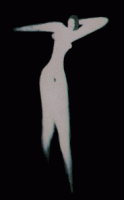
1992年の秋、私は作品と作者の関係を問い直すために、ある実験を試みた。友人の寺門孝之は、さまざまな電子メディア、新しい素材、古い時代の画像などを縦横に用い、彼独特の雰囲気をもった作品に仕上げていく画家で、その才能は広く認められている。彼の作品に、”TRANSGENIC ANGEL”と題されたシリーズがある。私はそのなかのある作品の一部分をスキャナーでディジタイズした。 彼がコピーマシン上の一瞬の動作で作り出すディストーションを模倣するコンピュータプログラムを作り、ディジタイズした画像データを処理した。私は自分の手元で、彼の作風に似た、彼が作ったかもしれない作品が生まれたことを確信した。
その作品を彼の作品群とともにバインダーで綴じ、彼のアトリエに向かった。ニコグラフで著作権に関するレクチャーを担当していた私は、彼に著作権についてのインタビューをする名目でビデオカメラを向け、そしてバインダーを彼に手渡した。
彼はめざとくその異物を発見し、一瞬のうちに事態を把握したようだった。彼は数分後、思考を整理しながら率直な感想を述べはじめた。 「自分の作品が、浄化されてここにあると感じた。ぼく自身では、そこまで浄化できないんだ。作品が印刷物になって姿を変えるときに感じるのと同じような、気持ちの良さを感じる。それはいったいどこからくるのかわからない、なにも土台がない、根拠の無いなつかしさだ。」
自分の作品が自分でさえ手に負えない推進力をもち、他人の手元で変化していく楽しさを、われわれは連画の作業を通して実感していた。寺門氏の反応は、引用する快楽だけでなく、引用される快楽について考える契機になった。
たとえば身体を触ったり触られたりすることは、状況によっては不愉快であり、状況によっては快楽をもたらす。われわれは不愉快を回避するルールとして、著作権という制度を発明したが、それは同時に触りあう快楽を自閉的な衣装の外に追い出すしくみであったかもしれない。ディジタルメディアはいま著作権という制度の無効性を暴きはじめているが、それと符合するように、ディジタルメディアは引用の快楽を増幅しはじめているとも言えるだろう。
われわれの第二のセッション「春の巻」は、同じ年の暮に始まり、今度は私が最初の一歩を踏み出すことになった。私はその意味の通り、踏み出そうとしている自分の足の写真をディジタイズし、中村に送った。中村は画像をプリントし、それにブルーのインクで加筆し、再びスキャナでディジタイズした。私は、その空から突き出したような足を渦巻状に変形し、「全自動洗濯機と熟練について」というタイトルをつけて返した。
そのようにして第二のセッションは、より自由で多様な変化を目指すという暗黙の合意の中で、ダイナミックに展開しはじめた。
-
SS09 画しきれない三美神
(Anzai)
-
SS10 フローラ現る 一人増えた
(Nakamura)
日常生活の中で拾ったテキストや画像がはめ込まれることもあった。画像の一部をほかのものに転換するという手法も頻繁に用いられた。また画像の引用ではなく、三角形から三美神というように概念的に連結したり、ボッティチェリの作品「春」をお互いが念頭において展開する部分もあった。
その制作過程で、中村理恵子が私にあてた一通の電子メールは、連画の意味を考える上で示唆に富むものであった。
「連画をやってるとき、自分と相手じゃなくて、自分っていう一人と、連衆としてのもう一人の私がキャッチボールをしていると思う。だから、むしろ、連衆につながって何かをするためには、強烈に自分に向き合い、自分に対していないと、できないことに気づく。連衆につながるってことは、、実はかえって、すごく個人の創作でありうる。ひとりで自分の絵を描いていると、なぜか、他人から投影された部分や、記憶が挟み込まれてきて、「あ、これは、**ちゃんの青だ…」とか、フっと気づくときがある。個人での創作は、ともするといろいろなものを小さく切り刻む作業になる。しかし、連衆であるときは、最初から、他がまじって作品がやってくる。その時、自分と他人を分けることからは、決してなにも始まらない。それごとまるごと飲み込んではじめて、オリジナルな自分のものにしてしまうことができる」
われわれは連画を通して、自分らしさというものが決して自分という単一の枠に閉じこめられた特質ではなく、また他者は自分自身の中にもいることを発見した。 われわれはしばしば、連画のコラボレーションは、二人の人格の融合による仮想の人格による創作ではないかという指摘を受けた。たとえば企業や国家といった共同体が、あたかもひとつの人格として振る舞うように。
しかしわれわれは連画の制作過程で、二人のユニットが一つの人格を形作るという感覚を、まったく持たなかった。自分の手元にある作品は、そのなかにどんなに他人の要素が入り込んでいても、他人との共有物ではなく、あくまで自分の作品と考えた。人格が解け合って巨大な人格が立ちあらわれるという考え方は、創造をする上で決して居心地のよいものではなかったからだ。
われわれはむしろ、自分の中に多くの他者の声のポリフォニーを聞いた。非常に孤独なモノローグだと信じられている創作が、実は自分の中の多くの他者とのダイアローグによって遂行されていることを実感した。自分らしさを、自分の固い殻の中にある他人らしくないものの集合として捉えていた私にとって、これは革新的な事件だった。
おそらく連歌という発明は、近代的な自己という装置が確立する以前の、自己とコミュニティーとの自然な相互作用を様式化したものだと考えられる。ディジタルメディアとネットワークコミュニティーは、単一の構造に固定化された人格の境界線を、無垢な状態に回復する力をもっている。それは新たな自己同一性の喪失をもたらすかもしれない。が、われわれにとってより自然で、なつかしいセルフイメージに出会う契機でもあるはずだ。
(1994 モンテカルロ IMAGINA’94 におけるレクチャー)
NOTE
Toshihiro ANZAI
The introduction of “Kokinshu (a collection of ancient and modern Japanese poetry)” compiled in the early tenth century contains the following passage: “Waka (Japanese poetry) move Heaven and Earth without the use of physical force.”
In modern times, literature is believed to develop in a metaphorical space outside of the physical space we inhabit. We all know that TV dramas are fiction and that fiction never interferes with reality. Before contemporary literature, however, metaphorical space and physical space were connected. Poetry was thought to mitigate a prevailing epidemic and occasionally served as a tool to lead a national project to success. Ancient people had a sense of awe and were moved by the mysterious power of words, which could affect an object without exerting any physical force.
I feel that such a richness of words is lacking in modern society.
The expression “could effect an object without exerting any physical force” could be applied to electronic media around us. It is digital technology that fuses physical and metaphorical space. Information network systems melt the long-frozen richness of the metaphorical space and restore its abundance to us. It also shows us that an archetype of our new experiences in electronic media goes back to the expression of ancient people.
Our project, “Renga”, was conceived at the conjunction point of classical and modern artform.
What triggered our idea was a workshop on computer painting held in the winter of 1991. A work by Rieko Nakamura was loaded into the painting system in front of me. Although it was digital data that could be reproduced an infinite number of times, I was reluctant to modify a completed work by someone else. But I dared to add some touches to it, and then “undid” the change. I repeated this process several times. This casual operation gave me a pleasant surprise. After a while I forgot about undoing it and further modified the work in my style until it became a sort of hybrid of my style with remnants of Nakamura’s.
In April of 1992, I suggested to Nakamura a creative method to make this scintillating play an organized activity. First, person A creates a seed work of CG (computer graphics) and sends it to person B through E-mail. Person B may use part of the work or alter it to create his/her own work and send back the result to person A. By repeating this process, a series of works just like a picture scroll will be created.
I named this method “Renga” (linked pictures) after the collective poetry style “Renga(linked poems).” Each member of the group, called “Renju”(linked members) will append a phrase in turn. “連 Ren” means link and “歌 Ga” means poem in this case. There is another kanji(Chinese character) which is pronounced “画 Ga” but means “picture”. Simply put, I coined the word “Renga(linked pictures)” by replacing the kanji for “poem” with the kanji for “picture.”
In “Renga(poetry)”, following the initial phrase called “Hokku” (which later became known in its independent form as “Haiku”), the second member creates the second phrase according to certain rules. A new meaning will be formed out of this relay. When the third phrase is added it opens up a completely new aspect. The “Renga” increases its chain of free association, just as the landscape through the window of a train constantly changes.
“Renga” was in fashion from the 14th to 15th century and then became formalized and lost its steam. Later it was revived as “Renga of Haiku”, called “Renku” and was brought to perfection in the 17th century by the poet Basho Matsuo. Basho is highly evaluated not only as a leader of the collective creative activities of “Renga,” but also as a master, in his own right, of “Haiku”. His devotees revealed Basho’s true perception of his own work was that; “I may be evaluated as a creator of “Haiku”, but the focus of my work is “Renga.”” This was surprising to the people even then. The 19th century poet Shiki Masaoka said that Basho’s “Haiku” was literature but his “Renga” was not.
Already by the time of Basho, “Renga” has been regarded as one rank lower than “Hokku”. Perhaps this is influenced by the common notion that a work of art should remain aloof and collaboration is thought to dilute the uniqueness of the work.
It is clear to see from our first six works, done in April 1992, that we were still too cautious about altering other people’s ideas, but at the same time it was stimulating to free ourselves of the notion that a work of art belongs only to the originator.
And we tapped into something beyond the outworn expression “individual and group” in a new framework of “individual and Ren”.
In the Autumn of 1992, I did an experiment to reassess the relationship between artists and their work. A friend of mine, Takayuki Terakado, is a painter who uses various electronic media, new materials and ancient images to create his works, producing a unique atmosphere. His talent is widely acknowledged. One of his works is a series titled “Transgenic Angel”. I scanned in some of it.
He creates a quick distortion effect using a photocopier. I wrote a computer program to simulate the effect and applied it to a digitized image. I was convinced that I had managed to create something similar to his. Something he might have created himself. I fastened it into a binder with his other works and on the pretext of interviewing him on the copyright system, about which I was soon to give a lecture at NICOGRAPH, headed for his atelier. I turned my video camera toward the artist and handed over the binder to him.
He quickly noticed my work and immediately figured it out. Then he gave me his honest impression of it. He said, “I feel that my work has been purified by this. I can’t reach this level myself. I felt the same pleasure that I usually feel when my own work is printed. I don’t know where it’s coming from. It is just a groundless, inexplicable sense of familiarity”.
The response of Terakado gave me a good opportunity to think not only about the pleasure of using others ideas, but also the pleasure of my own ideas being used by others.
Touching someone, either in a physical or spiritual sense, can be a pleasure in some cases, a discomfort in others. We invented the copyright system to avoid this discomfort. Perhaps it also serves as a mechanism to drive the pleasure of touching each other out of its cozy autism.
Digital media is beginning to divulge the invalidity of copyright system. At the same time it amplifies the pleasure of using each others works.
Our second session took place at the end of the same year. I took the first step, literally by taking a picture of my feet about to step forward. I digitized the photo and sent it to Nakamura. She printed out the image, added blue ink and scanned in the picture. The image of the feet sticking out of the blue sky was then deformed into whirlpool-like swirls as I sent it back to her with a title “On Fully Automatic Washing Machine and la Dexterite.”
There was a tacit agreement to go for freer and wider variation when the second session started.
We occasionally picked up a piece of text or image out of our daily life and put it into the work. Sometimes a part of the work was converted into another form. Not only usage of the image, but conceptual linkages, such as a triangle, to three deities of beauty, were used. Both of us once tried to hold the image of “Spring”, by Botticelli, in mind.
While pursuing “Renga”, I found one E-mail sent from Nakumura very inspiring as a clue to the meaning of “Renga.” It said that “”Renga” is not a play between oneself and others. I think it is a play catch between myself and another “Renju” self. To be connected with “Renju”, to achieve something, you have to face yourself, confront yourself or you just can’t make it. To be connected with “Renju” could be a very individual creative process. When I am painting alone, a projection from somebody or memory sneaks into the work. I notice it and say “Aha! This is the blue of Mr. A”. Individual work often tends to chop things into pieces but when you work with “Renju” you have to start with other elements. You can’t create anything by trying to separate yourself from others. Only by embracing it, you can make it your own original work.”
People pointed out that “Renga” is the creation of a virtual personality out of the fusion of two personalities. It is like enterprises and nations behaving as personalities. However, we have never felt a new personality during “Renga.” Although a streak of the other person is involved in the work, we regarded the work in hand as one’s own creation. A gigantic personality formed by the fusion of individuals was not a comfortable idea for us.
We prefer to regard creation, which is usually believed to be a solitary monologue, as being accomplished in dialogues with many other people within ourselves. This was a revelation to me. I used to believe that “the self” was a set of elements different from others, contained in a hard shell.
Perhaps the invention of “Renga(poetry)” is a formalization of the natural interaction between oneself and the community, before the establishment of the contemporary sense of self as a tool. Digital media and network communications have the power to bring the fixed boundary of personality back to its innocent state. It may cause a loss of identity but it would also serve as an opportunity to encounter the more natural and familiar self-image.
(IMAGINA’1994)
